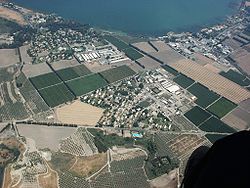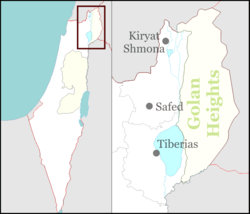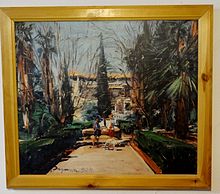- Degania Alef
-
Degania Alef 
Aerial photo showing Degania Alef
on the upper left sideFounded 1910 Founded by Jewish pioneers Council Emek HaYarden Region Jordan Valley Affiliation Kibbutz Movement Coordinates 32°42′29.16″N 35°34′29.63″E / 32.7081°N 35.5748972°ECoordinates: 32°42′29.16″N 35°34′29.63″E / 32.7081°N 35.5748972°E Population 517[1] (2008) Website www.degania.org.il Degania Alef (Hebrew: דְּגַנְיָה א', D'ganya Alef) is a kibbutz in northern Israel. It falls under the jurisdiction of the Emek HaYarden Regional Council.
Contents
History
Degania Alef was the first kibbutz established by Jewish Zionist pioneers in Palestine, then under Ottoman rule. It was founded in 1909 by the World Zionist Organization. In 1910 the land was handed over to a commune of workers which established itself on it in 1911.[2] Degania Bet was established to the south in 1920. On May 20, 1948 during the Battles of the Kinarot Valley, Degania Alef and Degania Bet repelled a Syrian attack.[2]
Degania Alef has been home to many prominent Israelis and members of the Yishuv. The poet Rachel, the "prophet of labor" A.D. Gordon, and Joseph Trumpeldor all worked at Degania Alef, whilst many early members of Degania Alef left to found other kibbutzim. Gideon Baratz was the first child ever to be born in a kibbutz and Moshe Dayan was the second, both in Degania Alef. Dayan was named after kibbutz member Moshe Barsky, the first kibbutz member to be killed in an Arab attack.[3] Barsky was killed in November, 1913. He was alone in the kibbutz fields when he was shot in the back and left for dead by Arab marauders.[4]
Both Deganias lie along the southern shores of the Sea of Galilee. Technically, Degania Alef is a kvutza and not a kibbutz - the distinction comes from its small size. Degania Alef is also distinctive in that children there never slept communally - children always slept in their parents' quarters.[citation needed]
In 1981, Kvutza Degania Alef was awarded the Israel Prize, for its special contribution to society and the State in social-human pioneering.[5]
In 2007, Degania Alef announced that it was to undergo privatization."[6] Instead of assigned jobs and equal pay under the rule of the elders, the reorganization will allow people to seek their jobs, earn their salaries, and own their homes, but still offer a social "safety net" for the weaker members of society.
In 1947 Degania Alef had a population of 380. During the 1948 Arab-Israeli war, the settlement was completely destroyed by the Syrian army.[7] According to a 1949 book by the Jewish National Fund, the village was destroyed following attacks on the neighboring Jewish villages of Shaar Hagolan and Massada. The settlers resisted, however, and launched a counter-attack which help to recover the neighboring settlements. Reconstruction started almost immediately. The name is derived from "dagan," meaning "corn." [8]
See also
References
- ^ "Locality File" (XLS). Israel Central Bureau of Statistics. 2008. http://www.cbs.gov.il/ishuvim/ishuv2008/bycode.xls. Retrieved 2010-06-22.
- ^ a b Mapa's concise gazetteer of Israel. Yuval El'azari (ed.). Tel-Aviv: Mapa Publishing. 2005. pp. 125. ISBN 9657184347. (Hebrew)
- ^ Taslitt, Israel Isaac (1969). Soldier of Israel: the story of General Moshe Dayan. p. 8: Funk and Wagnalls.
- ^ La Guardia, Anton (2002). War without end: Israelis, Palestinians, and the struggle for a promised land. p. 113: Macmillan.
- ^ "Israel Prize Official Site - Recipients in 1981 (in Hebrew)". http://cms.education.gov.il/EducationCMS/Units/PrasIsrael/Tashlag/Tashmab_Tashlag_Rikuz.htm?DictionaryKey=Tashma.
- ^ Tim McGirk (05-07-2007). "Postcard:Galilee". Time Magazine.
- ^ Martin Van Creveld (2002). The sword and the olive: a critical history of the Israeli defense force. PublicAffairs. pp. 79,82,180. ISBN 158648155X.
- ^ Jewish National Fund (1949). Jewish Villages in Israel. Jerusalem: Hamadpis Liphshitz Press. pp. 31.
Further reading
- Gavron, Daniel. The Kibbutz: Awakening from Utopia. Lanham, MD: Rowman & Littlefield, 2000.
External links
- Official website (Hebrew)
- A Day in Degania, from the Steven Spielberg Jewish Film Archive internet site
Kibbutzim Afikim · Alumot · Ashdot Ya'akov Ihud · Ashdot Ya'akov Meuhad · Beit Zera · Degania Alef · Degania Bet · Ein Gev · Ginosar · Hukok · Kvutzat Kinneret · Ma'agan · Masada · Ravid · Sha'ar HaGolan · Tel KatzirMoshavim Other villages Categories:- Emek HaYarden Regional Council
- Kibbutzim
- Kibbutz Movement
- Israel Prize for special contribution to society and the State recipients
- Israel Prize recipients that are organizations
- Populated places established in 1910
- Jewish villages in the Ottoman Empire
- Jewish villages in the Mandate for Palestine
Wikimedia Foundation. 2010.


